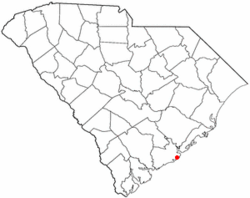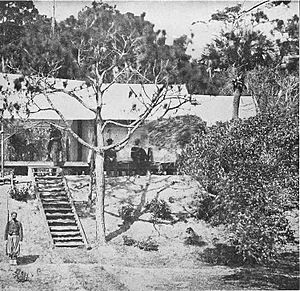Folly Island facts for kids
Quick facts for kids
Folly Island, South Carolina
|
|
|---|---|

Folly Beach
|
|

Location of Folly Beach in
South Carolina |
|
| Incorporated (Town) | 1938 |
| Incorporated (City) | 1957 |
| Area | |
| • Total | 18.87 sq mi (48.87 km2) |
| • Land | 12.51 sq mi (32.39 km2) |
| • Water | 6.36 sq mi (16.48 km2) |
| Elevation | 16 ft (5 m) |
| Population
(2010)
|
|
| • Total | 37,056 |
| • Estimate
(2019)
|
2,660 |
| • Density | 212.68/sq mi (82.12/km2) |
| Time zone | UTC-5 (EST) |
| • Summer (DST) | UTC-4 (EDT) |
| FIPS code | 45-26035 |
| GNIS feature ID | 1231287 |
Folly Island is a cool barrier island located in the Atlantic Ocean. You can find it near Charleston, South Carolina. It's one of the many Sea Islands and is part of Charleston County, South Carolina.
During the American Civil War, Folly Island was a really important spot. It was used as a main gathering place for Union Army troops. These soldiers were getting ready to attack Confederate forces in the Charleston area. The biggest town on Folly Island today is called Folly Beach.
Contents
What's in a Name?
The name "Folly" comes from an old English word. It means "dense foliage," which describes a place with lots of thick plants and trees.
Early Inhabitants
When Europeans first arrived on the island in the early 1600s, they met a Native American tribe called the Bohickets. We don't know much about what happened to them after the land was given to William Rivers in 1696.
Pirates and Old Tales
Pirates used to sail along the coast of South Carolina. They loved the many hidden inlets, sounds, and bays formed by islands like Folly Island. Two famous pirates who sailed these waters were Black Beard and Stede Bonnet.
For a while, Folly Island was even known as Coffin Island. But don't worry, it wasn't because of lots of deaths! It was named after the Coffin family, who owned large farms called plantations in nearby counties. In the past, people suffering from diseases like plague were sometimes taken to barrier islands like Folly Island instead of being brought into Charleston Harbor.
Folly Island During the Civil War
Folly Island played a big role in the American Civil War.
Small Skirmish
The only actual fighting on the island happened on May 10, 1863. Confederate forces attacked Union troops, but it was a very small fight. The Confederates were mostly trying to gather information.
Union Army Base
The Union Army took control of Folly Island in August 1863. They used it as a place to store supplies and as a camp for soldiers. These soldiers were trying to capture the city of Charleston. Folly Island stayed under Union control for the rest of the war.
Battles of Fort Wagner
Folly Island was the starting point for the Battles of Fort Wagner. These battles took place between July and September 1863. Fort Wagner was located on Morris Island, which is nearby. The Second Battle of Fort Wagner was even shown in the 1989 movie Glory.
A Soldier's Letter
A soldier named First Sergeant Robert John Simmons wrote a letter from Folly Island. He was part of the 54th Massachusetts Infantry Regiment. He wrote it just before he was badly wounded at Fort Wagner. His letter was published in a newspaper in December 1863.
Folly Island, South Carolina
July 18, 1863;
We are on the march to Fort Wagner, to storm it. We have just completed our successful retreat from James Island; we fought a desperate battle there Thursday morning. Three companies of us, B, H, and K, were out on picket about a good mile in advance of the regiment. We were attacked early in the morning. Our company was in the reserve, when the outposts were attacked by rebel infantry and cavalry. I was sent out by our Captain in command of a squad of men to support the left flank. The bullets fairly rained around us; when I got there the poor fellows were falling down around me, with pitiful groans. Our pickets only numbered about 250 men, attacked by about 900. It is supposed by the line of battle in the distance, that they were supported by reserve of 3,000 men. We had to fire and retreat toward our own encampment. One poor Sergeant of ours was shot down along side of me; several others were wounded near me.
God has protected me through this, my first fiery, leaden trial, and I do give Him the glory, and render my praises unto His holy name. My poor friend [Sergeant Peter] Vogelsang is shot through the lungs; his case is critical, but the doctor says he may probably live. His company suffered very much. Poor good and brave Sergeant (Joseph D.) Wilson of his company [H], after killing four rebels with his bayonet, was shot through the head by the fifth one. Poor fellow! May his noble spirit rest in peace. The General has complimented the Colonel on the gallantry and bravery of his regiment.
Modern Folly Island
Folly Island continues to be a special place today.
Music and Hurricanes
In the summer of 1934, a famous composer named George Gershwin and an author named DuBose Heyward visited Folly Island. They worked on their American folk opera called Porgy and Bess while they were there.
Folly Beach officially became a township in 1936 and a town in 1951.
Folly Beach can sometimes be affected by hurricanes that move up the Atlantic Coast. These storms bring strong winds, heavy rain, and big waves. This can cause the beach to wear away, which is called beach erosion. For example, Hurricane Irene in 2011 caused a lot of erosion. It even forced the popular Folly Beach County Park to close for a while.
Cannonball Discoveries
Even today, after big storms like Hurricane Matthew, people on Folly Beach still find cannonballs! These are often found by the Folly Beach Public Safety and Charleston County Bomb Squad. During Hurricane Matthew, 16 cannonballs were found in a "loading position." This means they were likely left behind by Union soldiers during the Civil War. They were found close together and hadn't exploded. More recently, a large cannonball was found on March 13, 2017, at the far end of the island. The Charleston County Bomb Squad is still looking into these discoveries.
Learning on Folly Island
Kids on Folly Island go to schools that are part of the Charleston County School District. Students attend James Island Elementary School, Camp Road Middle School, and James Island Charter High School.


